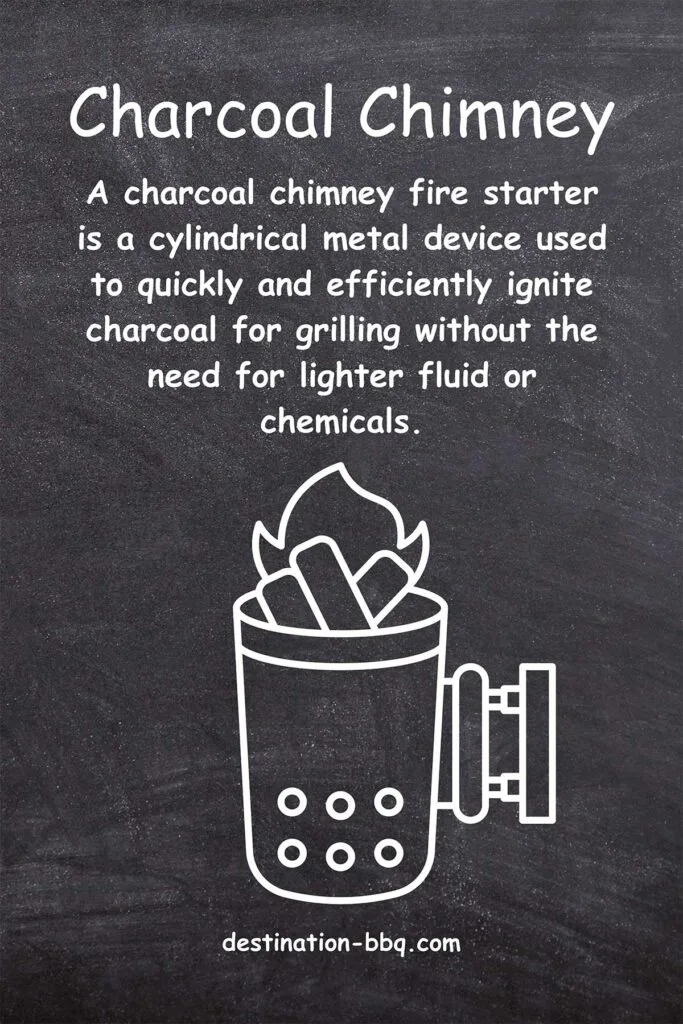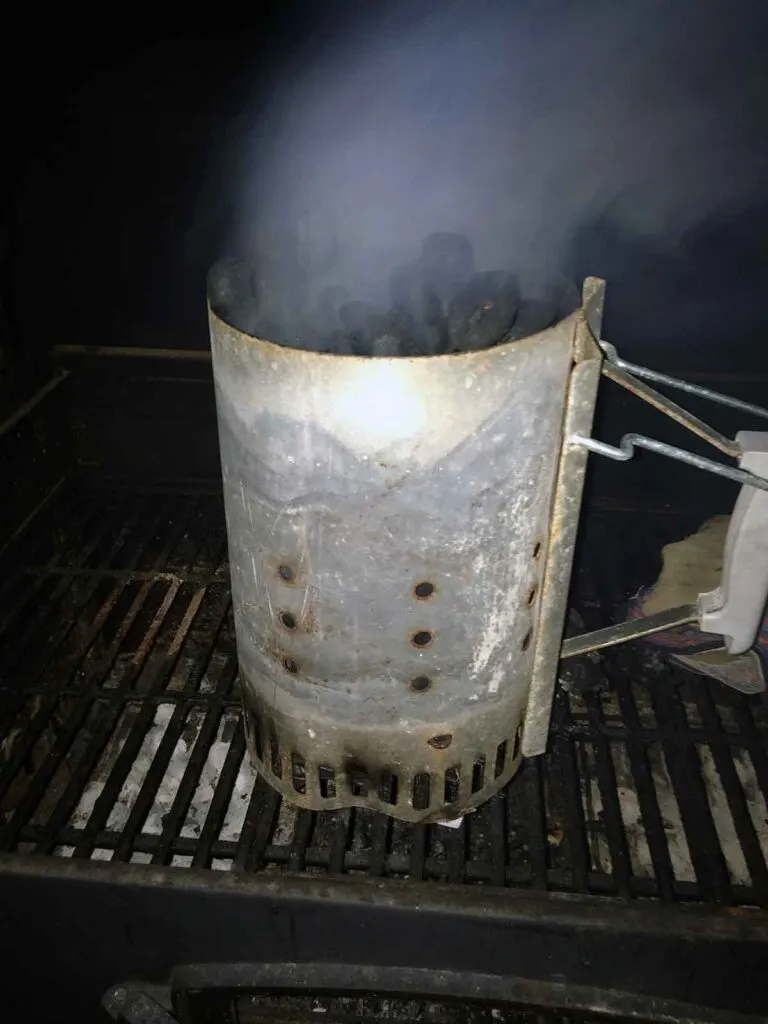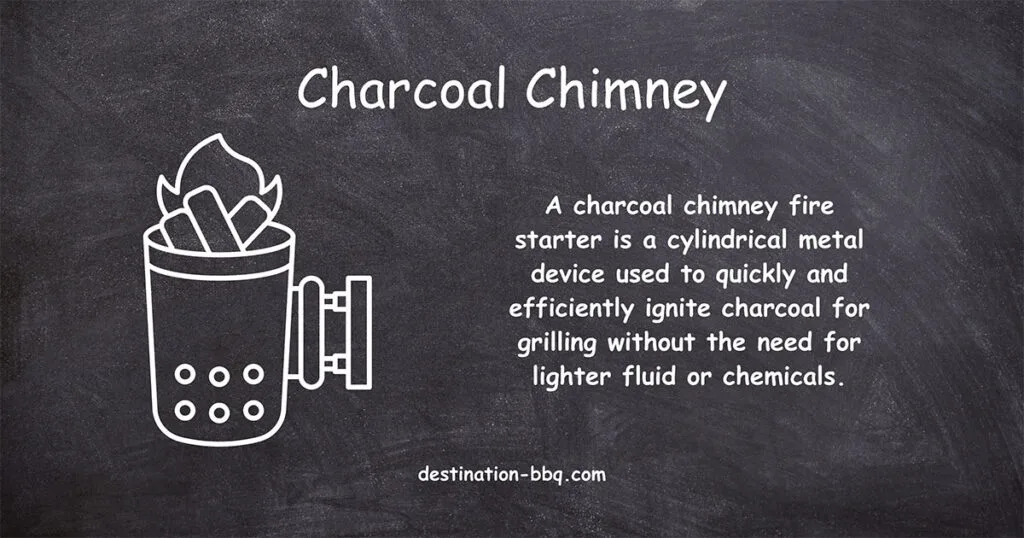
What is a Charcoal Chimney Fire Starter?
A charcoal chimney, often referred to as a chimney starter or charcoal chimney starter, is a handy tool that makes lighting your grill a breeze. It’s essentially a metal tube with a grate in the middle; you put newspaper or lighter cubes in the bottom, fill the top with charcoal, and light it up. Not only does this chimney starter quickly get your coals burning hot and even, but it also lets you ditch the lighter fluid, making your barbecue tastier and more eco-friendly.
Key Takeaways
- A charcoal chimney, also known as a chimney starter, is a metal cylinder with a grate inside that efficiently ignites charcoal for grilling without using lighter fluid.
- The chimney’s design allows for optimal airflow, which helps the charcoal to heat up quickly and evenly.
- Charcoal chimneys are environmentally friendly and enhance the flavor of grilled food by eliminating the need for chemical starters.
- The device is simple to use by placing kindling material at the bottom, filling the top with charcoal, and lighting the kindling to heat the charcoal.

“Fire starters are a fast and efficient way to start charcoal. The arch enemy of any BBQ is lighter fluid, as it can lend off flavors to the fire. Newspapers, in today’s age, are not as prevalent and probably not on hand. By using a fire starter, you are ensuring a safe and clean start to the grill.”
— Mike Lang, “Grillographer” of Another Pint Please, as quoted by The Spruce Eats
Understanding the Charcoal Chimney Starter
A charcoal chimney starter, also known as a chimney starter or fire starter, is an indispensable tool for barbecue enthusiasts and anyone who loves to grill. It’s a device specifically designed to efficiently ignite charcoal lumps or briquettes.
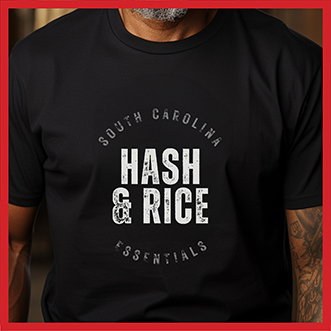
Gifts for Your Favorite Pitmaster
(even if that’s you!)
On
Etsy
Shirts, hats & more designed exclusively by Destination BBQ
The primary purpose of a charcoal chimney is to offer a quick and easy way to get your coals burning hot without the need for lighter fluid or any other chemicals, which can often leave an unpleasant taste on your food. That’s one of the main reasons a chimney is on our list of recommended products.
The basic structure of a chimney consists of a hollow metal cylinder, which is usually made of durable materials like steel or aluminum.
Inside the cylinder, there is a grate or shelf that separates the chimney into two sections. The lower section is where you place your kindling material, such as newspaper or lighter cubes, while the upper section is reserved for charcoal.
One of the key features of a fire starter is the ventilation. The metal tube has holes or vents, particularly in the lower section, which allow air to flow through. This airflow, or draft, is crucial as it provides the oxygen needed for the charcoal to ignite efficiently.
The top part of the chimney typically has a large opening where you can easily pour in the charcoal. It also has a handle, often with a heat shield, which allows you to safely grip and maneuver the chimney once the coals are hot and ready to be poured into the grill.
Using a chimney starter is not only an efficient way to light your coals but also an environmentally friendlier option compared to using lighter fluid. The absence of chemicals ensures that your grilled foods retain their natural flavors.
In summary, a charcoal chimney is:
- A tool for efficiently igniting charcoal for grilling.
- Comprised of a metal cylinder with a grate inside.
- Designed with ventilation for optimal airflow.
- A chemical-free alternative to lighter fluid.
- More environmentally friendly.
- Essential for achieving the perfect heat for your barbecue.
Why Use a Chimney?
Here are a few reasons why this fire starter is a must-have for any grilling aficionado:
- Faster Heating: Gets the coals hot quickly.
- No Chemical Taste: Avoids the chemical taste that lighter fluid can impart.
- Eco-friendly: Uses newspaper or lighter cubes, which are more environmentally friendly than lighter fluid.
- Controlled Heat: Allows for better control over the heat of your coals. Even Lighting: Ensures that all the coals are evenly lit, resulting in even cooking.
- Less Messy: Eliminates the need for pouring and spilling of lighter fluid.
- Cost-effective: Saves money in the long run as you don’t need to buy lighter fluid.
- Versatile: Can be used for any type of charcoal grill.
- Easy to Use: Simply fill the chimney with charcoal, light the newspaper or lighter cubes, and wait for the coals to heat up.
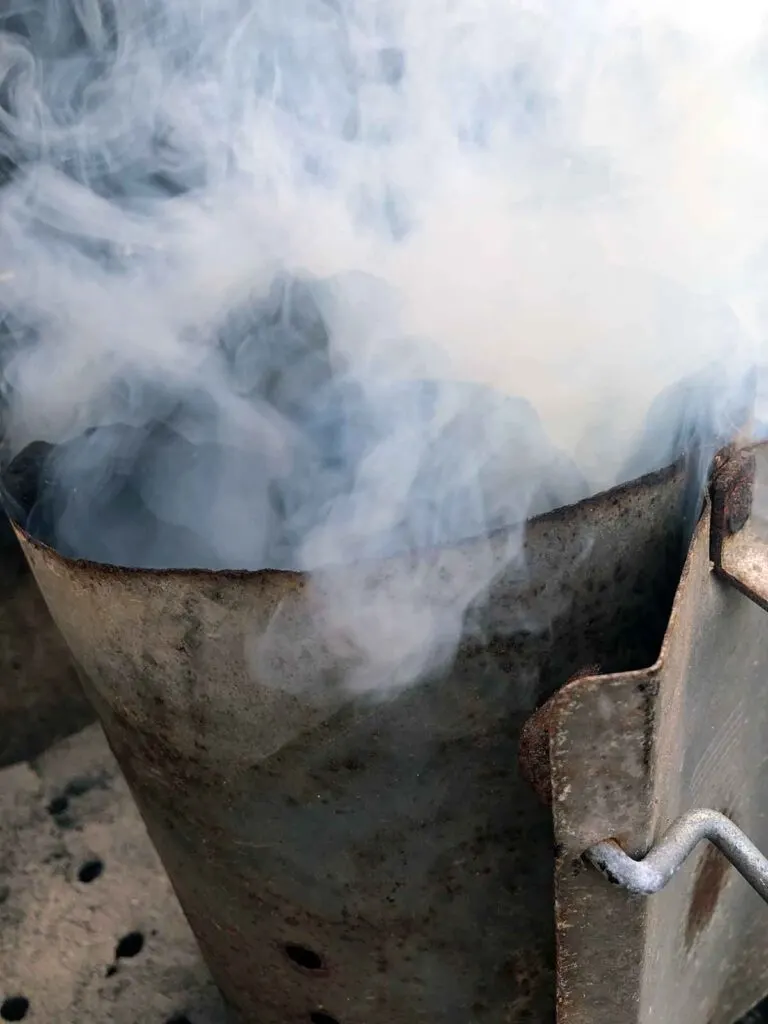
A Brief History
The charcoal chimney has a fascinating history that reflects the evolution of grilling and outdoor cooking. While today’s charcoal chimneys are sleek and efficient, the concept has been around for over a century.
Early Beginnings
The earliest known patent for a device resembling a charcoal chimney dates back to 1910. This early design, known as a “portable firebox,” was essentially a metal box with a grate and a handle. It was intended to light coals quickly and efficiently but lacked the cylindrical shape and ventilation of modern chimneys.
The Mid-20th Century: Kindle Cans
In the 1950s and 1960s, as backyard barbecues gained popularity in the United States, many grillers sought alternatives to lighter fluid, which was known to impart a chemical taste to the food. During this period, homemade versions of these chimneys, often referred to as kindle cans, became popular. These were typically made from metal coffee cans with holes punched in them for ventilation. A wire was attached as a handle, and a grate was placed inside to hold the charcoal.
The Modern Charcoal Chimney
The modern chimney, as we know it today, began to take shape in the 1970s and 1980s. During this time, several patents were filed for devices that closely resemble today’s chimney starters. These designs featured a cylindrical shape, which was found to be more efficient in directing airflow through the coals.
One of the most influential figures in the popularization of the modern charcoal chimney was George Stephen, the founder of Weber-Stephen Products Co. His company, Weber, became synonymous with quality grilling products, including the chimney starter.
The 21st Century: A Grilling Staple
Today, the charcoal chimney is a staple in the world of grilling. It comes in various sizes and materials, with additional features such as heat-resistant handles and secondary grates for cooking directly over the chimney. This modern, yet old-school fire starter continues to be celebrated for its environmental benefits, as it eliminates the need for chemical lighter fluids.
As the Illinois Sustainable Technology Center reported, “many people use lighter fluid to start charcoal, but a more sustainable option is to use a chimney starter which requires little to no liquid fuel.” While Hillside Woodfuels writes that “it’s a more eco-friendly grilling option. Using a charcoal chimney eliminates the need for petroleum-based lighter fluids, which are known to emit volatile organic compounds (VOCs) contributing to air pollution.”
How to Use a Charcoal Chimney: Step-by-Step
“Charcoal chimney starters are surprisingly simple to use,” write SmokeGears.com. “You place flammable material, like newspaper, at the bottom, and then charcoal on the top. Light the bottom, wait ten-to-fifteen minutes and your charcoal will be nice and hot! No fluids, no electricity, just heat doing the work for you.”
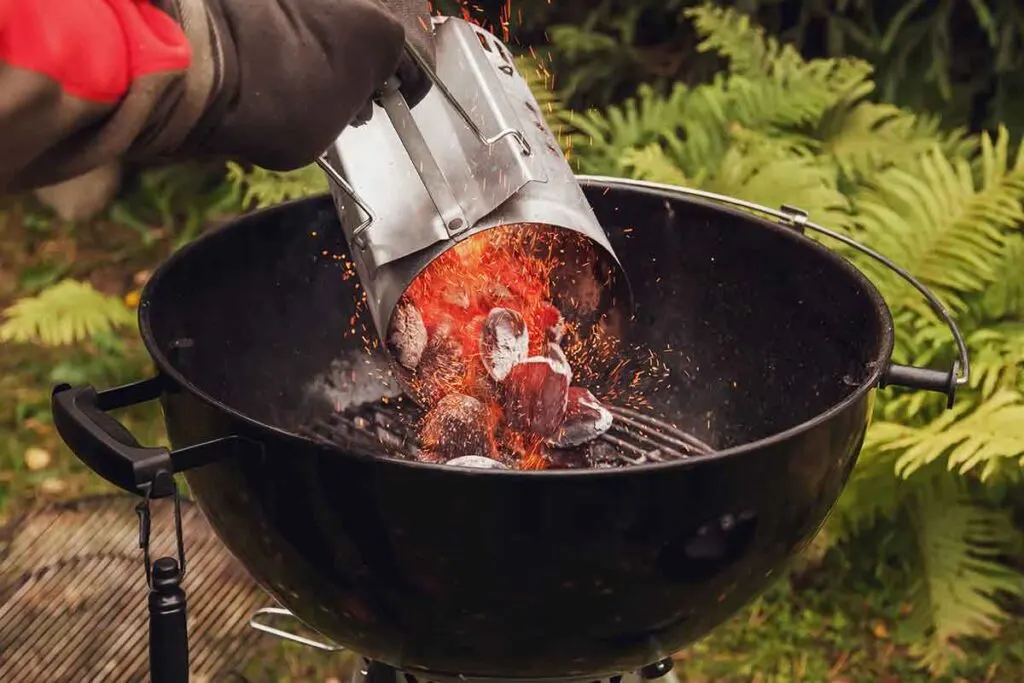
Tools and Materials
- Chimney
- Charcoal Briquettes or Lumps
- Newspaper, Paper, or Lighter Cubes
- Grill
- Heat-resistant Gloves
Step 1: Fill the Chimney
Place the chimney on your grill and fill it with charcoal.
Step 2: Add Starter Material
Place crumpled newspaper or a lighter cube under the grate of the chimney. (Pro tip: we simply tear off what we need from the top of the bag of charcoal we’re using, leaving enough headroom for the remaining charcoal in the bag.)
Step 3: Light It Up
Light the newspaper or lighter cube. The flames will rise up through the chimney, igniting the coals.
Step 4: Wait for the Coals to Heat
In about 15 minutes, the coals toward the top will start glowing red and the very top coals will start to show some gray ash. That’s when they’re ready to dump into your grill. Just don’t wait too long before you pour out your coals.
Dustin Green, head grill master for Weber, told Epicurious reporter Noah Kaufman that “you’ll actually end up losing fuel and heat that way. If you wait until they’re all the way ashed over, you’re going to lose half your chimney when you go to dump it. It’s already burnt up and done.”
Keep in mind that when you dump your coals you will be pouring the hot coals toward the bottom of the chimney on top of the coals that were starting to ashen at the top. In short order, this will ignite those coals that hadn’t yet fully started to burn. So, it is better to dump the coals a little too early than to dump them a little too late.
Step 5: Pour the Coals onto the Grill
Using heat-resistant gloves, carefully pour the hot coals onto the grill grate.
Safety Tips
- Always use heat-resistant gloves.
- Never use on a flammable surface.
- Keep water or a fire extinguisher nearby.
Advanced Techniques
- Measuring Charcoal: Use the chimney to measure charcoal for desired cooking temperatures.
- Direct Cooking: Cook directly over the chimney for high-intensity searing.
Choosing the Right Charcoal Chimney

Selecting the right fire starter is essential for ensuring an efficient and enjoyable grilling experience. With various brands, sizes, and features available, making the right choice can be daunting. In this section, we will guide you through the key factors to consider when choosing a charcoal chimney.
Material and Build Quality
The material of the charcoal chimney is crucial for durability and performance. Most chimneys are made of either steel or aluminum. Steel is generally more durable but can be heavier, while aluminum is lighter but may not last as long. Look for a chimney with sturdy construction and rust-resistant coating.
Size and Capacity
Charcoal chimneys come in different sizes, and the right choice depends on the size of your grill and the amount of food you typically cook. A larger chimney can hold more charcoal, which is ideal for larger grills or longer cooking sessions. Smaller chimneys are more portable and suitable for small grills or quick grilling.
“The bigger the chimney, the better,” Hardcore Carnivore host Jess Pryles told Insider. “Bigger chimneys mean you can light more coals, and that means more heat. Higher heat gives you a better sear, [along with] more flexibility and control over grill temperatures.”
Handle and Safety Features
Safety is paramount when dealing with hot coals. Look for a chimney starter with a heat-resistant handle and a heat shield. Some models feature a secondary handle, which provides better control when pouring hot coals.
“I like the Weber Rapidfire,” pitmaster Rodney Scott told Insider, “because it has two handles for extra grip, which makes sure that the pour is more accurate. It also has [quality] protection on the handle, which provides an extra shield to keep the heat off your hand.”
Ventilation
Proper airflow is essential for the efficient burning of coals. Ensure that the charcoal chimney has ample ventilation holes to allow for good airflow.
Additional Features
Some charcoal chimneys come with additional features such as a built-in grate for cooking directly over the chimney or a release mechanism for easier pouring of the coals.
Brand Reputation
Consider the reputation of the brand. Brands like Weber, Kingsford, and BBQ Dragon are known for producing high-quality grilling accessories, including charcoal chimneys.
Price
While it’s tempting to go for the cheapest option, it’s important to balance cost with quality. Investing in a durable and well-designed charcoal chimney can save you money in the long run.
Comparison Table
| Brand | Material | Size | Handle Type | Additional Features | Price | Link |
|---|---|---|---|---|---|---|
| Weber | Steel | Large | Heat-resistant | Built-in grate | $$ | Amazon |
| Kingsford | Aluminum | Medium | Heat shield | None | $ | Amazon |
| BBQ Dragon | Steel | Extra Large | Two Hands | 90-degree elbow | $$$ | Amazon |
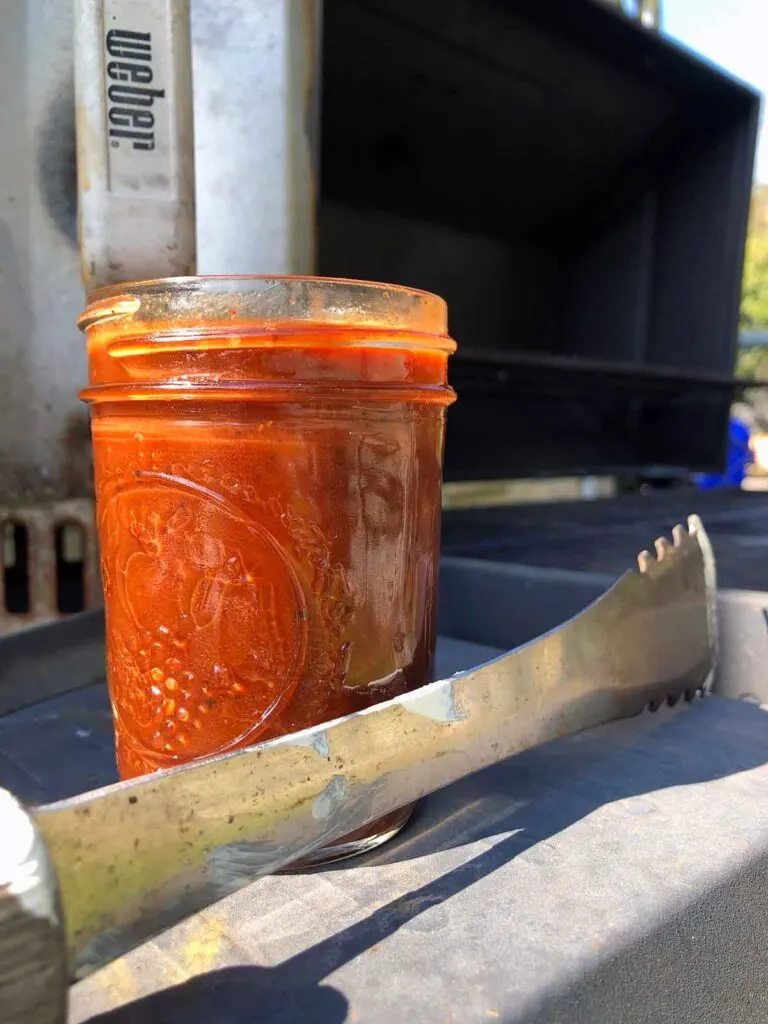
Choosing the right charcoal chimney involves considering the material, size, safety features, ventilation, brand reputation, and price. By taking these factors into account, you can select a charcoal chimney that meets your grilling needs and ensures a safe and enjoyable BBQ experience.
Frequently Asked Questions
While it’s possible to light charcoal without a chimney, using one offers several advantages. It allows for faster and more efficient lighting of the charcoal, eliminates the need for lighter fluid (which can affect the taste of your food), and provides more control over the heat of your coals. For these reasons, many grill enthusiasts consider a charcoal chimney an essential tool.
You should dump the coals from a charcoal chimney when they are glowing red and covered with a layer of gray ash. This usually takes about 10-20 minutes. It’s important not to dump the coals too early or too late to ensure optimal cooking temperatures. Keep in mind the coals at the bottom will be ready before those on top. When dumping them into a pile the hot coals will continue to ignite those that aren’t yet fully ashen. Finding the optimal moment will extend the life of your fire.
Typically, once ignited, you should leave the charcoal in the chimney for about 10-20 minutes. The exact time can vary depending on the type of charcoal, the amount, and the weather conditions. The key is to look for the coals to be glowing red and covered with gray ash, which indicates they are ready to be used for grilling.
If you don’t have a charcoal chimney, you can still light charcoal using alternative methods such as using lighter fluid, solid fire starters, or an electric charcoal starter. Today, pitmasters commonly use propane torches to start charcoal or wood. However, these methods may not be as efficient as using a charcoal chimney and may affect the taste of your food, especially if lighter fluid is used.
A full chimney of lump charcoal will typically burn for about 45 minutes to 1 hour at high temperatures. The exact duration can vary depending on factors such as the size of the charcoal pieces, the airflow in the grill, and the cooking temperature. Lump charcoal tends to burn hotter and faster than briquettes.
